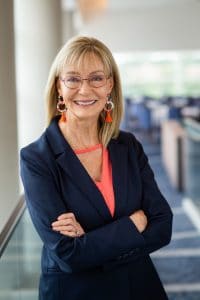PUBLISHED: 13th January 2021

by Carole Eldridge
In 2007, my 29-year-old daughter found a lump in her breast. We hadn’t seen much breast cancer in my relatives, but there was some pancreatic cancer on my husband’s side, so my daughter’s doctors at MD Anderson Cancer Center urged us to speak to a genetic counselor. From there, it was like an explosion in our family.
We were surprised to learn that my daughter, son and husband all had the BRCA1 c.181T>G mutation that increases risk for multiple cancers. The genetic counselor asked us to trace the mutation by drawing a family tree and noting how relatives had died. When my father-in-law was alive, I’d made fun of him for making genealogy books, but when we found out about BRCA1, I pulled those books out.
I started contacting relatives I hadn’t spoken to in a long time. I wasn’t just gathering information to fill in a chart. I wanted everyone to know that they could get screened and take steps to prevent early cancer.
At first, almost everyone denied that the situation was real or serious. There had been cancer deaths in the family, but we didn't see the pattern. Women died young of a disease that was embarrassing at the time; stigma or pain prevented talking about it.
When we began to see the pattern of cancer on my husband’s side of the tree, I felt that we had been assaulted. I couldn’t stand still and watch. I kept talking to relatives about cancer risk, without being too pushy. I learned from my mistakes. My daughter’s frightening cancer experience is what persuaded relatives to get screened for the mutation. Two young women in the family who saw what my daughter went through tested positive. They had preventive surgeries that affected their fertility—one decided not to have children, the other decided to adopt. Those two women stopped the chain of high cancer risk.
We had other happy endings, too. My daughter froze embryos before her chemotherapy so that she could have a family. Through in vitro fertilization, she selected unimpaired embryos, and she now has two beautiful children who do not have the family mutation.
While my husband was participating in a pancreatic cancer screening study, doctors found a cyst and removed part of his pancreas. I have no doubt that he would have developed pancreatic cancer without our knowledge of this mutation.
I kept digging further into our family tree. When I researched all the children of my husband’s third-great-grandparents, I found that a mother, along with her daughter and granddaughter had all died young. The granddaughter had been connected with FORCE. This connection to FORCE made me feel like there was someone else who cared.
My daughter had more decisions to make. She had been advised to remove her ovaries by age 40, but she wanted to keep them a little longer. Before she decided, she wanted know how common early ovarian cancer was with her specific mutation.
Looking for answers, I started a Facebook group for people with my daughter’s mutation. Women who joined were often struggling with the same overwhelming decisions. Do I have my ovaries removed and deal with early menopause? Should I try hormone replacement therapy? . I’m inspired by these young women. They’re jumping in with both feet and asking for help. They’re trying to get every bit of information from every source they can to figure out what’s best for them. My daughter found cases of ovarian cancer that helped her decide when to have surgery.
My family’s need for information pushes me to learn more about the risk of pancreatic cancer related to this mutation. I found ConnectMyVariant, a project that links people who have the same mutations, brought more members to our Facebook group and jumpstarted my genealogy, so I can find more cousins and make sure that they are aware of their cancer risk.
The more I learn, the more I feel in control. Knowing that my relatives have this mutation, that their cancers can be prevented, and that we can do our own research to learn even more about our risks has been life- and sanity-saving. It’s made me feel I can do something about the cancer clinging to our family tree.
 Carole Eldridge is a registered nurse, yoga instructor, health educator, and the wife and mother of people with the BRCA1 c.181T>G variant. The article was shaped with the help of Caitlin Shirts.
Carole Eldridge is a registered nurse, yoga instructor, health educator, and the wife and mother of people with the BRCA1 c.181T>G variant. The article was shaped with the help of Caitlin Shirts.
1 Comments
January 17, 2021
Excellent presentation & article. Thank you for ALWAYS thinking of others & sharing your knowledge. I am so thankful for excellent oncologist and the power of prayer! March 2021 I will reach 30 years as a breast cancer survivor‼️ I appreciate you Carole‼️
Nelda Davis
Reply